Impact of Service Life on the Environmental Performance of Buildings
Abstract
1. Introduction
1.1. Service Life Estimation
- ESL = Estimated service life of building components
- RSL = Reference service life of building components
- Factor A = Quality of components including manufacturing, storage, transport and protective coating etc.
- Factor B = Design level including incorporation, sheltering by rest of structure and surrounding buildings
- Factor C = Work execution level, site management, workmanship level, weather condition during work
- Factor D = Indoor environment conditions, humidity, ventilation, and condensation etc.
- Factor E = Outdoor environment, microenvironmental conditions, weathering factors, building elevation etc.
- Factor F = In-use conditions, mechanical impact, wear and tear, category user etc.
- Factor G = Maintenance level, quality and frequency.
1.2. Environmental Life Cycle Assessment
2. Method
3. Case Studies
4. Results and Discussion
4.1. Estimated Service Life
4.2. Cumulative Energy Demand
4.3. GHG Emissions
4.4. Land Use
4.5. Water Consumption
5. Conclusions
Author Contributions
Funding
Acknowledgments
Conflicts of Interest
Appendix A
| Material (tonnes) | Building-50 | 1. TF-CB-CC | 2. TF-CB-FAGC | 3. TF-CB-GGBFS | 4. TF-DB-CC | 5. TF-DB-FAGC | 6. TF-DB-GGBFS | 7. SF-CB-CC | 8. SF-CB-FAGC | 9. SF-CB-GGBFS | 10. SF-DB-CC | 11. SF-DB-FAGC | 12. SF-DB-GGBFS |
|---|---|---|---|---|---|---|---|---|---|---|---|---|---|
| 1. Excavation of foundation | 26.83 | 26.83 | 26.83 | 26.83 | 26.83 | 26.83 | 26.83 | 26.83 | 26.83 | 26.83 | 26.83 | 26.83 | 26.83 |
| 2. Sand: Sub-base | 26.01 | 26.01 | 26.01 | 26.01 | 26.01 | 26.01 | 26.01 | 26.01 | 26.01 | 26.01 | 26.01 | 26.01 | 26.01 |
| 3. On grade slab (including water proofing membrane, mesh reinforcement, ready mix concrete-N20) | 79.56 | 79.56 | 79.56 | 79.56 | 79.56 | 79.56 | 79.56 | 79.56 | 79.56 | 79.56 | 79.56 | 79.56 | 79.56 |
| 4. Floor Tiles (Ceramic) | 5.47 | 5.47 | 5.47 | 5.47 | 5.47 | 5.47 | 5.47 | 5.47 | 5.47 | 5.47 | 5.47 | 5.47 | 5.47 |
| 5. Concrete Blocks wall (including mortar, steel rebar, metal lintels) | 75.78 | 75.78 | 75.78 | 75.78 | 75.78 | 75.78 | |||||||
| 6. Bricks (including mortar, metal lintels) | 107.4 | 107.4 | 107.4 | 107.4 | 107.4 | 107.4 | 107.4 | ||||||
| 7. Plaster | 10.54 | 10.54 | 10.54 | 10.54 | 10.54 | 10.54 | 10.54 | 10.54 | 10.54 | 10.54 | 10.54 | 10.54 | 10.54 |
| 8. Rendering | 13.86 | 13.86 | 13.86 | 13.86 | 13.86 | 13.86 | |||||||
| 9. Gypsum board ceiling | 2.19 | 2.19 | 2.19 | 2.19 | 2.19 | 2.19 | 2.19 | 2.19 | 2.19 | 2.19 | 2.19 | 2.19 | 2.19 |
| 10. Roof Timber (including bat insulation) | 4.61 | 4.61 | 4.61 | 4.61 | 4.61 | 4.61 | 4.61 | ||||||
| 11. Roof Steel (including bat insulation) | x | x | x | x | x | x | x | 2.33 | 2.33 | 2.33 | 2.33 | 2.33 | 2.33 |
| 12. Terracotta roof tiles | 16.55 | 16.55 | 16.55 | 16.55 | 16.55 | 16.55 | 16.55 | 16.55 | 16.55 | 16.55 | 16.55 | 16.55 | 16.55 |
| 13. Metal door frames: 12 no. | 0.18 | 0.18 | 0.18 | 0.18 | 0.18 | 0.18 | 0.18 | 0.18 | 0.18 | 0.18 | 0.18 | 0.18 | 0.18 |
| Door shutters: 12 no. | 0.37 | 0.37 | 0.37 | 0.37 | 0.37 | 0.37 | 0.37 | 0.37 | 0.37 | 0.37 | 0.37 | 0.37 | 0.37 |
| 14. Aluminum windows: Single glazed | 1.43 | 1.43 | 1.43 | 1.43 | 1.43 | 1.43 | 1.43 | 1.43 | 1.43 | 1.43 | 1.43 | 1.43 | 1.43 |
| Total material transported to construction site | 254.3 | 236.5 | 236.5 | 236.5 | 254.3 | 254.3 | 254.3 | 234.3 | 234.3 | 234.3 | 252 | 252 | 252 |
| Total material transported to landfill | 26.83 | 26.83 | 26.83 | 26.83 | 26.83 | 26.83 | 26.83 | 26.83 | 26.83 | 26.83 | 26.83 | 26.83 | 26.83 |
| Material (tonnes) | Building-50 | 1. TF-CB-CC | 2. TF-CB-FAGC | 3. TF-CB-GGBFS | 4. TF-DB-CC | 5. TF-DB-FAGC | 6. TF-DB-GGBFS | 7. SF-CB-CC | 8. SF-CB-FAGC | 9. SF-CB-GGBFS | 10. SF-DB-CC | 11. SF-DB-FAGC | 12. SF-DB-GGBFS |
|---|---|---|---|---|---|---|---|---|---|---|---|---|---|
| Terracotta tiles | 16.55 | 16.55 | 16.55 | 16.55 | 16.55 | 16.55 | 16.55 | 16.55 | 16.55 | 16.55 | 16.55 | 16.55 | |
| Gypsum board | 2.19 | 2.19 | 2.19 | 2.19 | 2.19 | 2.19 | 2.19 | 4.38 | 4.38 | 2.19 | 4.38 | 4.38 | |
| Plaster | 21.08 | 21.08 | 21.08 | 21.08 | 21.08 | 21.08 | 21.08 | 21.08 | 21.08 | 21.08 | 21.08 | 21.08 | |
| Render | 41.58 | 41.58 | 41.58 | n/a | n/a | n/a | 41.58 | 55.44 | 55.44 | n/a | n/a | n/a | |
| Ceramic tiles | 0 | 0 | 0 | 0 | 0 | 0 | 0 | 5.47 | 5.47 | 0 | 5.47 | 5.47 | |
| Total material transported to site for replacement works | 81.4 | 81.4 | 81.4 | 39.8 | 39.8 | 39.8 | 81.4 | 102.9 | 102.9 | 39.8 | 47.5 | 47.5 | |
| Total material transported to landfill | 81.4 | 81.4 | 81.4 | 39.8 | 39.8 | 39.8 | 81.4 | 102.9 | 102.9 | 39.8 | 47.5 | 47.5 |
| Carriage (tkm) | Building-50 | 1. TF-CB-CC | 2. TF-CB-FAGC | 3. TF-CB-GGBFS | 4. TF-DB-CC | 5. TF-DB-FAGC | 6. TF-DB-GGBFS | 7. SF-CB-CC | 8. SF-CB-FAGC | 9. SF-CB-GGBFS | 10. SF-DB-CC | 11. SF-DB-FAGC | 12. SF-DB-GGBFS |
|---|---|---|---|---|---|---|---|---|---|---|---|---|---|
| Sand for levelling | 1300.5 | 1300.5 | 1300.5 | 1300.5 | 1300.5 | 1300.5 | 1300.5 | 1300.5 | 1300.5 | 1300.5 | 1300.5 | 1300.5 | 1300.5 |
| Material to site | 6848.4 | 6316.2 | 6316.2 | 6316.2 | 6848.4 | 6848.4 | 6848.4 | 6247.8 | 6247.8 | 6247.8 | 6780 | 6780 | 6780 |
| Construction waste | 342.42 | 315.81 | 315.81 | 315.81 | 342.42 | 342.42 | 342.42 | 312.39 | 312.39 | 312.39 | 339 | 339 | 339 |
| Dirt to landfill | 1341.5 | 1341.5 | 1341.5 | 1341.5 | 1341.5 | 1341.5 | 1341.5 | 1341.5 | 1341.5 | 1341.5 | 1341.5 | 1341.5 | 1341.5 |
| Material to landfill | 1683.92 | 1657.31 | 1657.31 | 1657.31 | 1683.92 | 1683.92 | 1683.92 | 1653.89 | 1653.89 | 1653.89 | 1680.5 | 1680.5 | 1680.5 |
| Carriage (tkm) | Building-50 | 1. TF-CB-CC | 2. TF-CB-FAGC | 3. TF-CB-GGBFS | 4. TF-DB-CC | 5. TF-DB-FAGC | 6. TF-DB-GGBFS | 7. SF-CB-CC | 8. SF-CB-FAGC | 9. SF-CB-GGBFS | 10. SF-DB-CC | 11. SF-DB-FAGC | 12. SF-DB-GGBFS |
|---|---|---|---|---|---|---|---|---|---|---|---|---|---|
| Material to site | 2442.0 | 2442.0 | 2442.0 | 1194.6 | 1194.6 | 1194.6 | 2442.0 | 3087.6 | 3087.6 | 1194.6 | 1424.4 | 1424.4 | |
| Construction waste | 122.1 | 122.1 | 122.1 | 59.7 | 59.7 | 59.7 | 122.1 | 154.4 | 154.4 | 59.7 | 71.2 | 71.2 | |
| Material to landfill | 4070.0 | 1341.5 | 1341.5 | 1991.0 | 1991.0 | 1991.0 | 4070.0 | 5146.0 | 5146.0 | 1991.0 | 2374.0 | 2374.0 | |
| Total material to landfill | 4192.1 | 1463.6 | 1463.6 | 2050.7 | 2050.7 | 2050.7 | 4192.1 | 5300.4 | 5300.4 | 2050.7 | 2445.2 | 2445.2 |
| Energy | Energy Consumption GJ/year |
|---|---|
| Non-thermal energy (home appliances, lighting) | 18.834 |
| Thermal energy (heating/cooling) | 10.430 |
| Natural gas consumption (hot water) | 22.610 |
| Total energy (use stage) | 51.874 |
| Replacements of Building Components | Building-50 | 1. TF-CB-CC | 2. TF-CB-FAGC | 3. TF-CB-GGBFS | 4. TF-DB-CC | 5. TF-DB-FAGC | 6. TF-DB-GGBFS | 7. SF-CB-CC | 8. SF-CB-FAGC | 9. SF-CB-GGBFS | 10. SF-DB-CC | 11. SF-DB-FAGC | 12. SF-DB-GGBFS |
|---|---|---|---|---|---|---|---|---|---|---|---|---|---|
| Building | 50 | 57 | 57 | 57 | 57 | 57 | 57 | 57 | 65 | 65 | 57 | 66 | 69 |
| Terracotta tiles | 0 | 1 | 1 | 1 | 1 | 1 | 1 | 1 | 1 | 1 | 1 | 1 | 1 |
| Gypsum board | 0 | 1 | 1 | 1 | 1 | 1 | 1 | 1 | 2 | 2 | 1 | 2 | 2 |
| Plaster | 0 | 2 | 2 | 2 | 2 | 2 | 2 | 2 | 2 | 2 | 2 | 2 | 2 |
| Render | 0 | 3 | 3 | 3 | n/a | n/a | n/a | 3 | 4 | 4 | n/a | n/a | n/a |
| Ceramic tiles | 0 | 0 | 0 | 0 | 0 | 0 | 0 | 0 | 1 | 1 | 0 | 1 | 1 |
| Remaining Life (years) | Building-50 | 1. TF-CB-CC | 2. TF-CB-FAGC | 3. TF-CB-GGBFS | 4. TF-DB-CC | 5. TF-DB-FAGC | 6. TF-DB-GGBFS | 7. SF-CB-CC | 8. SF-CB-FAGC | 9. SF-CB-GGBFS | 10. SF-DB-CC | 11. SF-DB-FAGC | 12. SF-DB-GGBFS |
|---|---|---|---|---|---|---|---|---|---|---|---|---|---|
| Building | 50 | 57 | 57 | 57 | 57 | 57 | 57 | 57 | 65 | 65 | 57 | 66 | 69 |
| Terracotta tiles | 41 | 41 | 41 | 41 | 41 | 41 | 41 | 32 | 29 | 41 | 32 | 29 | |
| Gypsum board | 3 | 3 | 3 | 3 | 3 | 3 | 3 | 25 | 25 | 3 | 24 | 21 | |
| Roof frame | 0 | 0 | 0 | 0 | 0 | 0 | 29 | 21 | 21 | 29 | 20 | 17 | |
| Plaster | 21 | 21 | 21 | 21 | 21 | 21 | 21 | 13 | 13 | 21 | 12 | 9 | |
| Render | 3 | 3 | 3 | n/a | n/a | n/a | 3 | 10 | 10 | n/a | n/a | n/a | |
| Wall frame | 8 | 8 | 8 | 25 | 25 | 25 | 8 | 0 | 0 | 25 | 16 | 13 | |
| Ceramic tiles | 0 | 0 | 0 | 0 | 0 | 0 | 0 | 39 | 39 | 0 | 38 | 35 | |
| Slab footing | 0 | 9 | 12 | 0 | 9 | 12 | 0 | 9 | 12 | 0 | 9 | 12 |
References
- Grant, A.; Ries, R.; Kibert, C. Life cycle assessment and service life prediction: A case study of building envelope materials. J. Ind. Ecol. 2014, 18, 187–200. [Google Scholar] [CrossRef]
- Nunen, H.V. Assessment of the Sustainability of Flexible Building: The Improved Factor Method: Service Life Prediction of Buildings in The Netherlands, Applied to Life Cycle Assessment. Ph.D. Thesis, Universiteit Eindhoven, Eindhoven, The Netherlands, 2010. [Google Scholar]
- Leticia, O.M.; Begoña, S.L. Proposed method of estimating the service life of building envelopes. J. Constr. 2015, 14, 60–88. [Google Scholar]
- Rauf, A.; Crawford, R.H. The relationship between material service life and the life cycle energy of contemporary residential buildings in Australia. Artich. Sci. Rev. 2013, 56, 252–261. [Google Scholar] [CrossRef]
- Robert, H.; Crawford, R.J.F. Energy and greenhouse gas emissions implications of alternative housing types for Australia. In Proceedings of the State of Australian Cities National Conference Australian Sustainable Cities and Regions Network (ASCRN), Melbourne, VIC, Australia, 29 November–2 December 2011; pp. 1–12. [Google Scholar]
- Robert, H.; Crawford, I.C.; Robert, J.F. A comprehensive framework for assessing the life-cycle energy of building construction assemblies. Archit. Sci. Rev. 2010, 53, 288. [Google Scholar]
- Silvestre, J.D.; Silva, A.; de Brito, J. Uncertainty modelling of service life and environmental performance to reduce risk in building design decisions. J. Civ. Eng. Manag. 2015, 21, 308–322. [Google Scholar] [CrossRef]
- Ramesh, T.; Prakash, R.; Shukla, K.K. Life cycle energy analysis of a residential building with different envelopes and climates in Indian context. Appl. Energy 2012, 89, 193–202. [Google Scholar] [CrossRef]
- Allacker, K. Sustainable Building: The Developement of an Evaluation Method. Ph.D. Thesis, Katholieke Universiteit Leuven, Leuven, Belgium, 2010. [Google Scholar]
- Audenaert, A.; de Cleyn, S.H.; Buyle, M. Lca of low energy flats using the eco-indicator 99 method: Impact of insulation materials. Energy Build. 2012, 47, 68–73. [Google Scholar] [CrossRef]
- Carre, A. A Comparative Life Cycle Assessment of Alternative Constructions of a Typical Australian House Design; PNA147-0809; Forest & Wood Products Australia: Melbourne, Australia, 2011. [Google Scholar]
- Iyer-Raniga, U.; ChewWong, J.P. Evaluation of whole life cycle assessment for heritage buildings in australia. Build. Environ. 2012, 47, 138–149. [Google Scholar] [CrossRef]
- Rouwette, R. Lca of Brick Products; Think Brick Australia: Melbourne, Australia, 2010. [Google Scholar]
- Cuellar-Franca, R.M.; Azapagic, A. Environmental impacts of the UK residential sector: Life cycle assessment of houses. Build. Environ. 2012, 54, 86–99. [Google Scholar] [CrossRef]
- Nemry, F.; Uihlein, A.; Colodel, C.M.; Wetzel, C.; Braune, A.; Wittstock, B.; Hasan, I.; Kreißig, J.; Gallon, N.; Niemeier, S.; et al. Options to reduce the environmental impacts of residential buildings in the european union-potential and costs. Energy Build. 2010, 42, 976–984. [Google Scholar] [CrossRef]
- Ortiz-Rodríguez, O.; Castells, F.; Sonnemann, G. Life cycle assessment of two dwellings: One in spain, a developed country, and one in colombia, a country under development. Sci. Total Environ. 2010, 408, 2435–2443. [Google Scholar] [CrossRef] [PubMed]
- Cabeza, L.F.; Rincón, L.; Vilariño, V.; Pérez, G.; Castell, A. Life cycle assessment (lca) and life cycle energy analysis (lcea) of buildings and the building sector: A review. Renew. Sustain. Energy Rev. 2014, 29, 394–416. [Google Scholar] [CrossRef]
- Biswas, W.K. Carbon footprint and embodied energy assessment of a civil works program in a residential estate of western australia. Int. J. Life Cycle Assess. 2014, 19, 732–744. [Google Scholar] [CrossRef]
- Islam, H.; Jollands, M.; Setunge, S. Life cycle assessment and life cycle cost implication of residential buildings—A review. Renew. Sustain. Energy Rev. 2015, 42, 129–140. [Google Scholar] [CrossRef]
- Atmaca, A. Life-cycle assessment and cost analysis of residential buildings in south east of turkey: Part 2—A case study. Int. J. Life Cycle Assess. 2016, 21, 925–942. [Google Scholar] [CrossRef]
- Lawania, K.K.; Biswas, W.K. Achieving environmentally friendly building envelope for western australia’s housing sector: A life cycle assessment approach. Int. J. Sustain. Built Environ. 2016, 5, 210–224. [Google Scholar] [CrossRef]
- Manish, K.; Dixit, J.L.F.; Lavy, S.; Charles, H.C. Need for an embodied energy measurement protocol for buildings: A review paper. Renew. Sustain. Energy Rev. 2012, 16, 3730–3743. [Google Scholar]
- Vitale Pierluca, A.N.; Fabrizio, D.G.; Umberto, A. Life cycle assessment of the end of life phase of a residential building. Waste Manag. 2017, 60, 311–321. [Google Scholar] [CrossRef]
- Pierluca Vitale, U.A. An attributional life cycle assessment for an italian residential multifamily building. Environ. Technol. 2018, 39, 3033–3045. [Google Scholar] [CrossRef]
- Balasbaneh, A.T.; Marsono, A.K.B.; Khaleghi, S.J. Sustainability choice of different hybrid timber structure for low medium cost single-story residential building: Environmental, economic and social assessment. J. Build. Eng. 2018, 20, 235–247. [Google Scholar] [CrossRef]
- Buildings and constructed assets—Service life planning. Part-1: General Principles and Framework; ISO 15686-1; International Standards Organisation: Geneva, Switzerland, 2011. [Google Scholar]
- Hed, G. Service life planning of building components. Durab. Build. Mater. Compnt. 1999, 8, 1543–1551. [Google Scholar]
- Hovde, P.J.; Moser, K. Performance Based Methods for Service Life Prediction; In-House Publishing: Rotterdam, The Netherlands, 2004. [Google Scholar]
- Masters, L.W.; Brandt, E. Prediction of service life of building materials and components. Mater. Struct. 1987, 20, 55–77. [Google Scholar] [CrossRef]
- Building and constructed assets—Service planning. Part 1: General Principals and Framework; ISO 15686-1:2000; International Standards Organisation: Geneva, Switzerland, 2000. [Google Scholar]
- Buildings and constructed assets—Service life planning. Part-2: Service Life Prediction Procedures; ISO 15686-2; International Standards Organisation: Geneva, Switzerland, 2012. [Google Scholar]
- Cecconi, F. Performance lead the way to service life prediction. In Proceedings of the 9th International Conference on Durability of Building Materials and Components, Brisbane, Australia, 17–20 March 2002. [Google Scholar]
- Ivan Cole, P.C. Predicting the service life of buildings and components. Constr. Mater. 2011, 164, 305–314. [Google Scholar] [CrossRef]
- Chen, C.-J.; Juan, Y.-K.; Hsu, Y.-H. Developing a systematic approach to evaluate and predict building service life. J. Civ. Eng. Manag. 2017, 23, 890–901. [Google Scholar] [CrossRef]
- Hovde, P.J. Performance Based Methods for Service Life Prediction, Part A: Factor Methods for Service Life Prediction. Available online: http://site.cibworld.nl/dl/publications/Pub294.pdf (accessed on 1 January 2019).
- Hovde, P.J. Evaluation of the Factor Method to Estimate the Service Life of Building Components; Department of Building and Construction Engineering, The Norwegian University of Science and Technology: Trondheim, Norway, 1998. [Google Scholar]
- Buildings and constructed assets—Service-life planning. Part 8: Reference Service Life and Service-Life Estimation; ISO 15686-8; International Standards Organisation: Geneva, Switzerland, 2008. [Google Scholar]
- Environmental Management—Life Cycle Assessment, Principles and Framework; ISO 14040; International Standards Organization: Geneva, Switzerland, 2006.
- Guinee, J.B.; Udo de Haes, H.A.; Huppes, G. Quantitative life cycle assessment of products: 1: Goal definition and inventory. J. Clean. Prod. 1993, 1, 3–13. [Google Scholar] [CrossRef]
- Consoli, F.A.; Boustead, I.; Fava, J.; Franklin, W.; Jensen, A.; Oude, N.; Parrish, R.; Perriman, R.; Postlethwaite, D.; Quay, B.; et al. Guide Lines for Life-Cycle Assessment: A Code of Practice; Society of Environmental Toxicology and Chemistry: Pensacola, FL, USA, 1993. [Google Scholar]
- Bekker, P.C.F. A life cycle approach in building. Build. Environ. 1982, 17, 3–13. [Google Scholar] [CrossRef]
- Ortiz, O.; Castells, F.; Sonnemann, G. Sustainability in the construction industry: A review of recent developments based on lca. Constr. Build. Mater. 2009, 23, 28–39. [Google Scholar] [CrossRef]
- Lotteau, M.; Loubet, P.; Pousse, M.; Dufrasnes, E.; Sonnemann, G. Critical review of life cycle assessment (lca) for the built environment at the neighborhood scale. Build. Environ. 2015, 93, 165–178. [Google Scholar] [CrossRef]
- Anderson, J.E.; Wulfhorst, G.; Lang, W. Expanding the use of life-cycle assessment to capture induced impacts in the built environment. Build. Environ. 2015, 94, 403–416. [Google Scholar] [CrossRef]
- Passer, A.; Ouellet-Plamondon, C.; Keneally, P.; John, V.; Habert, G. Impact of future scenarios on building renovation strategies towards plus energy buildings. SBE16 Zurich 2016, 124, 2. [Google Scholar]
- Norman, J.; MacLean, H.; Kennedy, C.A. Comparing high and low residential density: Life-cycle analysis of energy use and greenhouse gas emissions. J. Urban Plan. Dev. 2006, 132, 10–21. [Google Scholar] [CrossRef]
- Wahidul, K.; Biswasa, Y.A.; Krishna, K.L.; Prabir, K.S.; Elsarrag, E. Life cycle assessment for environmental product declaration of concrete in the gulf states. Sustain. Cities Soc. 2017, 35, 36–46. [Google Scholar]
- Lawania, K.K.; Biswas, W.K. Cost-effective ghg mitigation strategies for western australia’s housing sector: A life cycle management approach. Clean Technol. Environ. Policy 2016, 18, 2419–2428. [Google Scholar] [CrossRef]
- Werner, F.; Richter, K. Wooden building products in comparative lca. Int. J. Life Cycle Assess. 2007, 12, 470–479. [Google Scholar]
- Wahidul, K.; Biswas, L.B.; Carter, D. Global warming potential of wheat production western australia: A life cycle assessment. Water Environ. J. 2008, 22, 206–216. [Google Scholar]
- Mirabella, N.; Röck, M.; Saade, M.R.M.; Spirinckx, C.; Bosmans, M.; Allacker, K.; Passer, A. Strategies to improve the energy performance of buildings: A review of their life cycle impact. Buildings 2018, 8, 105. [Google Scholar] [CrossRef]
- Vincenzo Franzitta, M.L.; Gennusa, G.P.; Rizzo, G.; Scaccianoce, G. Toward a european eco-label brand for residential buildings: Holistic or by-components approaches? Energy 2011, 36, 1884–1892. [Google Scholar] [CrossRef]
- Francesco Barreca, P.P. Post-occupancy evaluation of buildings for sustainable agri-food production—A method applied to an olive oil mill. Buidings 2018, 8, 83. [Google Scholar] [CrossRef]
- Samaratunga, M.; Ding, L.; Bishop, K.; Prasad, D.; Yee, K.W.K. Modelling and Analysis of Post-Occupancy Behaviour in Residential Buildings to Inform Basix Sustainability Assessments in Nsw. Procedia Eng. 2017, 180, 343–355. [Google Scholar] [CrossRef]
- Aneurin Grant, R.R. Impact of building service life models on life cycle assessment. Build. Res. Inf. 2013, 41, 168–186. [Google Scholar] [CrossRef]
- Galle, W.; de Temmerman, N.; de Meyer, R. Integrating scenarios into life cycle assessment: Understanding the value and financial feasibility of a demountable building. Buidings 2017, 7, 64. [Google Scholar] [CrossRef]
- TCI. Australia’s Emissions: What Do the Numbers Really Mean? The Climate Institute: Sydney Australia, 2015. [Google Scholar]
- Argent, R.M. Australia State of the Environment 2016: Inland Water; Australian Government Department of the Environment and Energy: Canberra, Australia, 2017. [Google Scholar]
- BOM. Average Anual, Seasonal and Monthly Rainfall; BOM: Melbourne, Australia, 2018. [Google Scholar]
- Pfister, S.; Koehler, A.; Hellweg, S. Assessing the environmental impacts of freshwater consumption in lca. Environ. Sci. Technol. 2009, 43, 4098–4104. [Google Scholar] [CrossRef] [PubMed]
- Fenton, G.G. Desalination in australia-past and future. Desalination 1981, 39, 399–411. [Google Scholar] [CrossRef]
- Radcliffe, J.C. The water energy nexus in australia-the outcome of two crises. Water-Energy Nexus 2018, 1, 66–85. [Google Scholar] [CrossRef]
- Joe Pickin, P.R. Australian National Waste Report 2016; Department of the Environment and Energy & Blue Environment Pty Ltd.: Docklands, Australia, 2017. [Google Scholar]
- PRe’-Consultants. Simapro 8.4 Lca Software; Pre’ Consultants: Amersfoort, The Netherlands, 2016. [Google Scholar]
- Shahana, Y.; Janjua, P.K.S.; Wahidul, K.B. Sustainability implication of a residential building using a lifecycle assessment approach. In Proceedings of the 4th International Conference on Low Carbon Asia and Beyond (ICLCA), Johor Bahru, Malaysia, 24–26 October 2018; Chemical Engineering Transactions: Johor Bahru, Malaysia, 2018; Volume 73, pp. 1–6. [Google Scholar]
- AccuRate. Accurate Sustainability Tool Version 2.3.3.13 sp3; CSIRO Land & Water Flagship and Distributed by Energy Inspection Pty Ltd.: Canberra, Austrailia, 2015. [Google Scholar]
- Crowther, P. Design for disassembly to recover embodied energy. In Proceedings of the 16th International conference on Passive and Low Energy Architecture, Melbourne/Brisbane/Cairns, Australia, 22–24 September 1999. [Google Scholar]
- Lawania, K.K. Improving the Sustainability Performance of Western Australian House Construction: A Life Cycle Management Approach; Curtin University: Perth, Australia, 2016. [Google Scholar]
- Treloar, G.; Fay, R.; Love, P.E.D.; Iyer-Raniga, U. Analysing the life-cycle energy of an australian residential building and its householders. Build. Res. Inf. 2000, 28, 184–195. [Google Scholar] [CrossRef]
- Fay, R.; Treloar, G.; Iyer-Raniga, U. Life-cycle energy analysis of buildings: A case study. Build. Res. Inf. 2000, 28, 31–41. [Google Scholar] [CrossRef]
- Vass, N. Western Australia Energy Fact Sheet. Available online: http://www.australianpowerproject.com.au/western-australia-energy-fact-sheet/ (accessed on 19 December 2018).
- Lawania, K.; Biswas, W.K. Application of life cycle assessment approach to deliver low carbon houses at regional level in western australia. Int. J. Life Cycle Assess. 2018, 23, 204–224. [Google Scholar] [CrossRef]
- Allacker, K.; Maia de Souza, D.; Sala, S. Land use impact assessment in the construction sector: An analysis of lcia models and case study application. Int. J. Life Cycle Assess. 2014, 19, 1799–1809. [Google Scholar] [CrossRef]
- Spang, E.S.; Moomaw, W.R.; Gallagher, K.S.; Kirshen, P.H.; Marks, D.H. The water consumption of energy production: An international comparison. Environ. Res. Lett. 2014, 9, 1–14. [Google Scholar] [CrossRef]
- Bardhan, S. Assessment of water resource consumption in building construction in India. WIT Trans. Ecol. Environ. 2011, 144, 93–101. [Google Scholar]
- Robert, H.G.; Treloar, J.T. An assessment of the energy and water embodied in commercial building construction. In Proceedings of the 4th Australian Life Cycle Assessment Conference, Sydney, NSW, Australia, 23–25 February 2005; pp. 1–10. [Google Scholar]
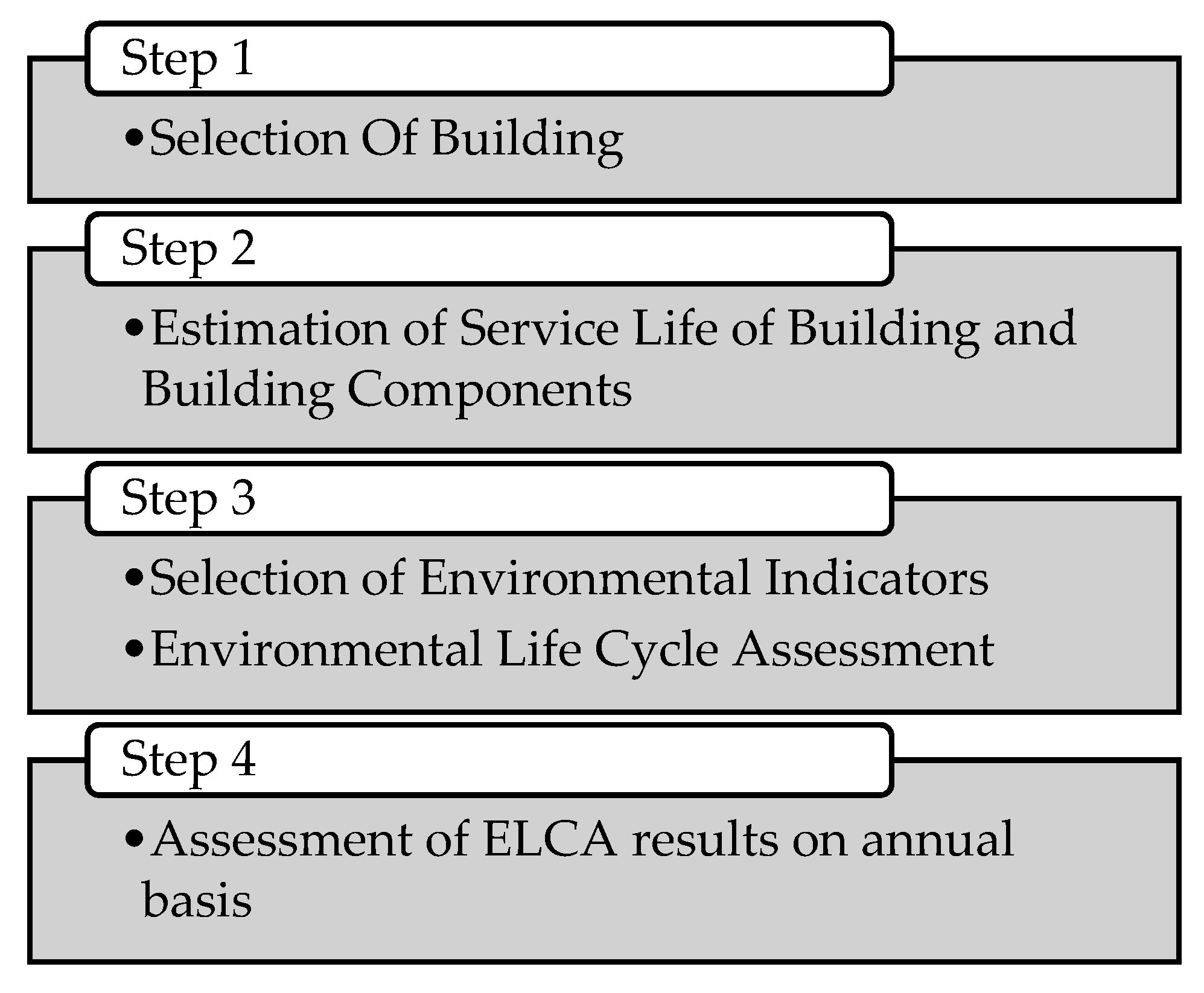
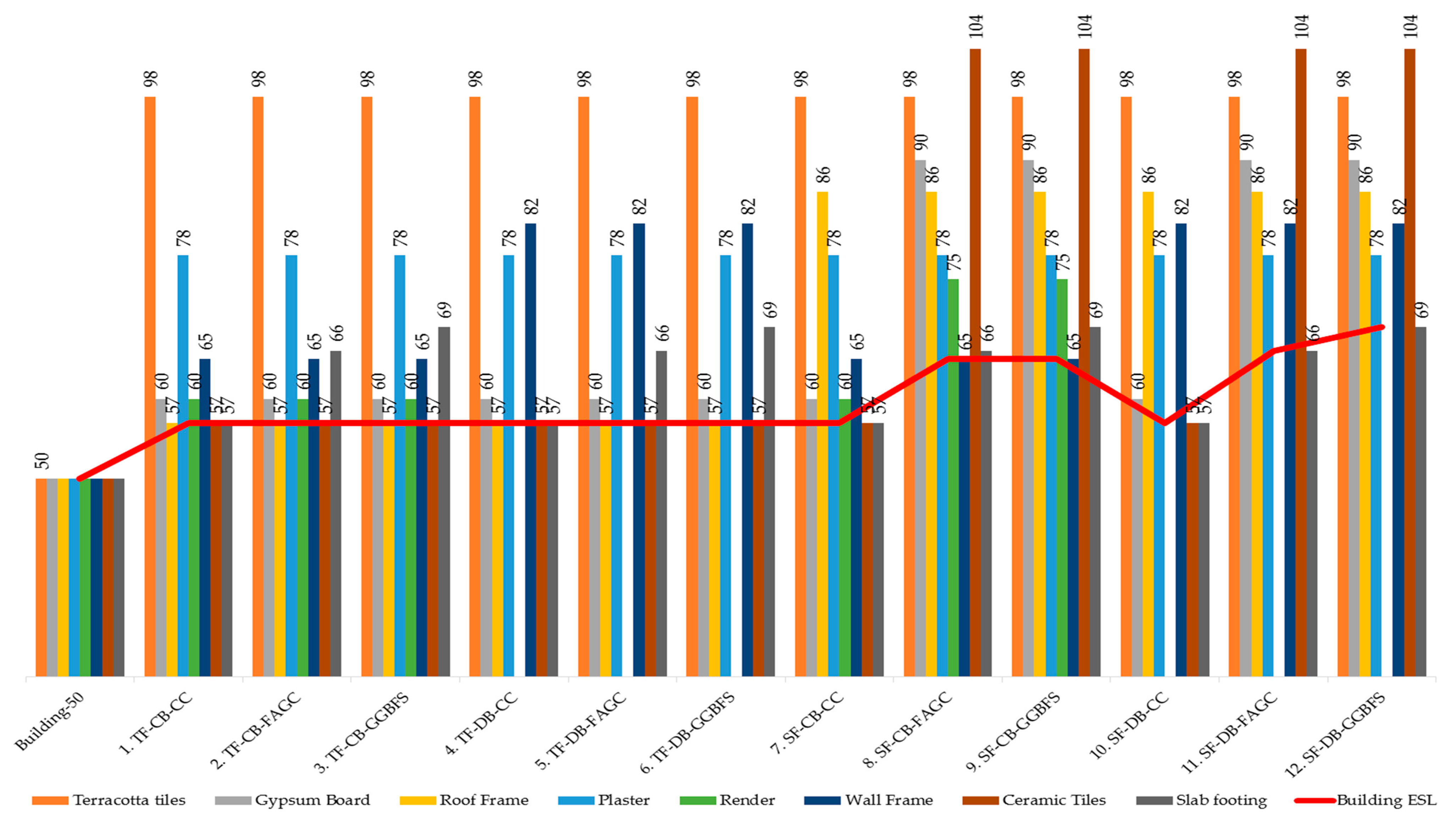
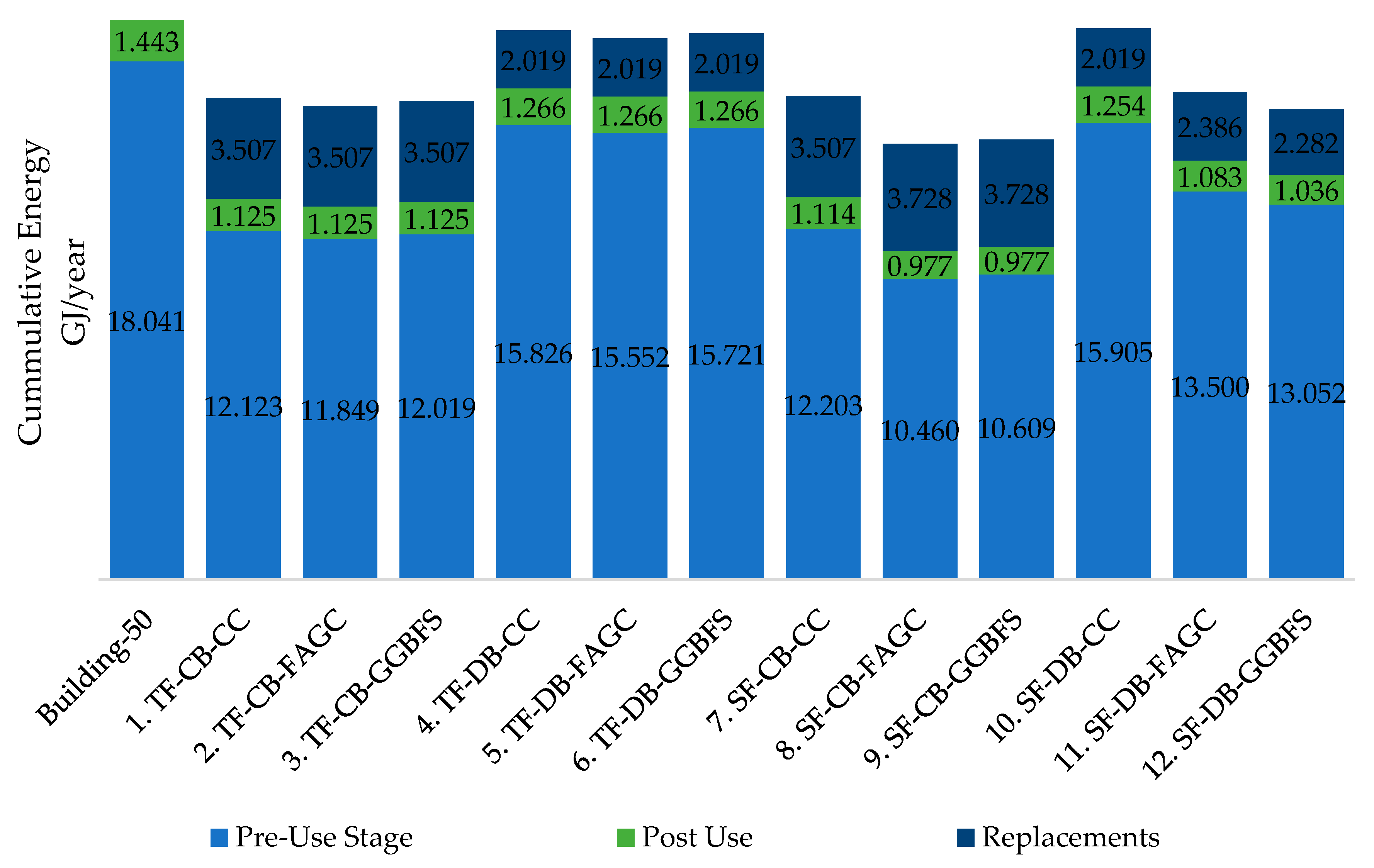
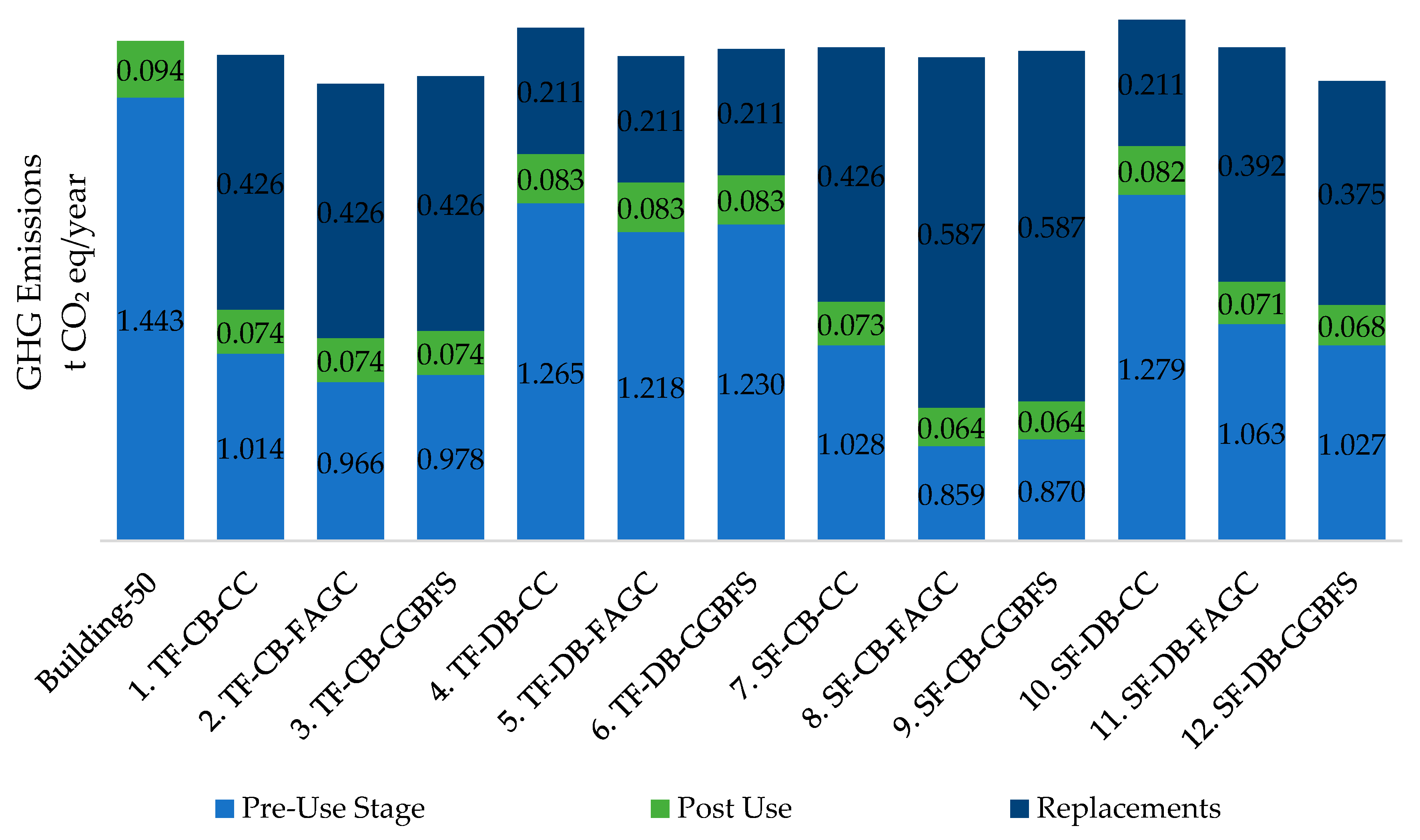
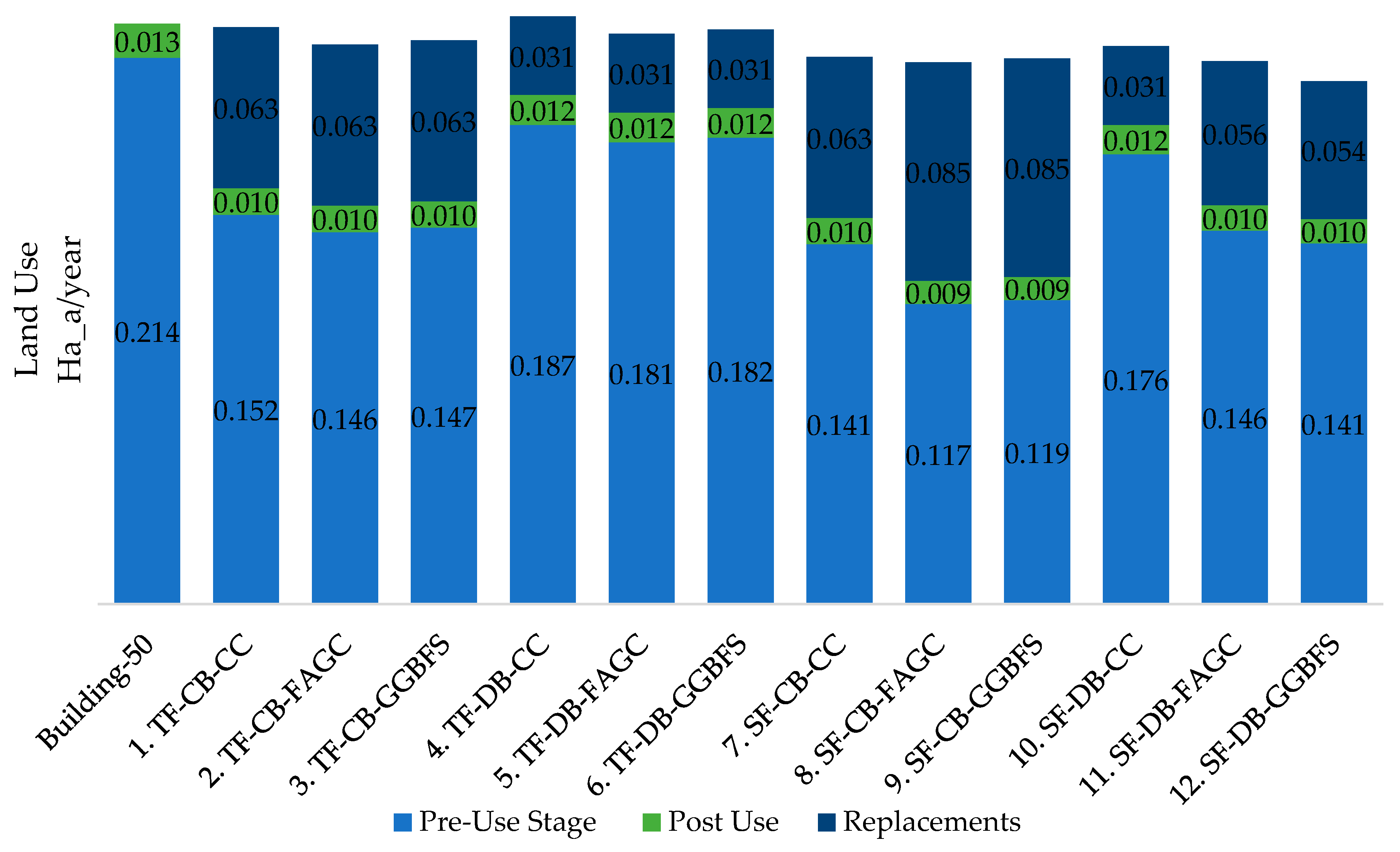
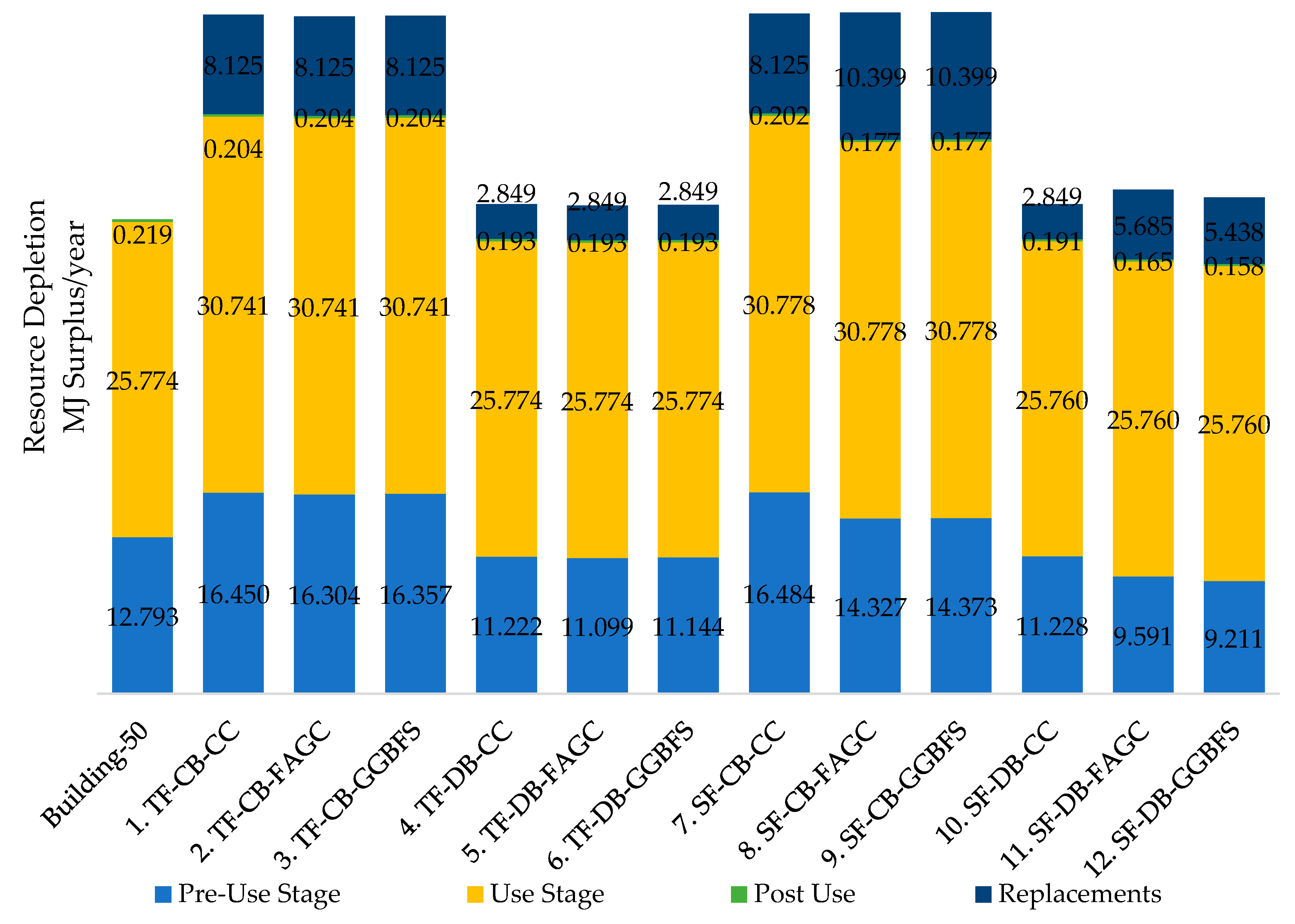
| Author | Life Span (Years) | Impact Indicators |
|---|---|---|
| Ramesh et al. [8] | 75 | Life cycle energy demand |
| Allacker K. [9] | 60 | External costs |
| Audenaert A. [10] | 50 | Waste generation |
| Carre A. [11] | 60 | Global warming potential (GWP), Cumulative energy demand (CED), water use, solid waste, photochemical oxidation, eutrophication, land use, and resource depletion |
| Iyer-Raniga U. [12] | 100 | Carbon emission, energy, photochemical oxidation, eutrophication, land use and water use |
| Rouwette R. [13] | 50 | GHG, CED |
| Cuellar-Franca R.M. [14] | 50 | GWP, acidification, eutrophication, abiotic depletion, ozone depletion, photochemical ozone creation, human toxicity |
| Nemry F. [15] | 40 | GWP, primary energy, acidification, eutrophication, ozone depletion, photochemical, ozone creation |
| Ortiz O. [16] | 50 | GWP, acidification, human toxicity, abiotic depletion, ozone depletion |
| Crawford et al. [6] | 50 | Embodied energy, cost, operational energy |
| Cabeza et al. [17] | 30 to 100 mostly 50 | Life cycle energy |
| Biswas W.K. [18] | 50 | GHG emissions, Embodied energy (EE) |
| Islam H. [19] | 50 | Life cycle energy, life cycle cost (LCC) |
| Atmaca A. [20] | 30 to 100 mostly 50 | GHG emissions |
| Lawania K.K. [21] | 50 | GHG emissions, life cycle energy |
| Grant A. [1] | Estimated | GWP, atmospheric ecotoxicity, atmospheric acidification |
| Dixit M.K. [22] | 50 | Embodied energy |
| Vitale P. [23] | 50 | GWP, respiratory inorganics potential, non-renewable energy potential, waste framework directive |
| Vitale P. [24] | 50 | Respiratory inorganics, GWP, non-renewable energy |
| Balasbaneh A.T. [25] | 50 | GWP, human toxicity, acidification, eutrophication, LCC, labor wage rate, job creation |
| Building | Building Specifications | Building Components | ||
|---|---|---|---|---|
| Roof Frames | Wall Frames | Slab Footing | ||
| Building-50 | TF-DB-CC | Timber frame | Double Brick | Conventional concrete |
| 1 | TF-CB-CC | Timber frame | Concrete Block | Conventional concrete |
| 2 | TF-CB-FAGC | Timber frame | Concrete Block | 30% FA Green concrete |
| 3 | TF-CB-GGBFS | Timber frame | Concrete Block | 30% GGBFS Green concrete |
| 4 | TF-DB-CC | Timber frame | Double Brick | Conventional concrete |
| 5 | TF-DB-FAGC | Timber frame | Double Brick | 30% FA Green concrete |
| 6 | TF-DB-GGBFS | Timber frame | Double Brick | 30% GGBFS Green concrete |
| 7 | SF-CB-CC | Steel Frame | Concrete Block | Conventional concrete |
| 8 | SF-CB-FAGC | Steel Frame | Concrete Block | 30% FA Green concrete |
| 9 | SF-CB-GGBFS | Steel Frame | Concrete Block | 30% GGBFS Green concrete |
| 10 | SF-DB-CC | Steel Frame | Double Brick | Conventional concrete |
| 11 | SF-DB-FAGC | Steel Frame | Double Brick | 30% FA Green concrete |
| 12 | SF-DB-GGBFS | Steel Frame | Double Brick | 30% GGBFS Green concrete |
| Factor Description | Roof System | Wall System | Footing System | ||||||||||
|---|---|---|---|---|---|---|---|---|---|---|---|---|---|
| Factor | Criteria | Timber Truss | Steel Truss | Terracotta Tiles | Gypsum board | Concrete Block | Double Brick | Plaster | Render | CC | 30% FAGC | 30% GGBFS | Ceramic Tiles |
| A | A = 1.1, Best Available Material; A = 1.05, Good Material; A=1.0, N/A-No effects; A = 0.95, Slightly low Standard material; A = 0.90, Low Standard Material | 1.10 | 1.10 | 1.10 | 1.10 | 1.10 | 1.10 | 1.05 | 1.05 | 1.05 | 1.05 | 1.10 | 1.10 |
| B | B = 1.1, Best Design with special considerations to strengthen the structure; B = 1.05, Good Design, (as per standards approach); B = 1.0, N/A-No effects; B = 0.95, low Standard design; B = 0.90, poor design | 1.05 | 1.05 | 1.00 | 1.00 | 1.10 | 1.10 | 1.05 | 1.05 | 1.05 | 1.05 | 1.05 | 1.00 |
| C | C=1.1, Satisfaction Level ≥ 90%; C = 1.05, 80% < Satisfaction Level > 90%; C = 1.0, N/A-No effect; C = 0.95, 70% < Satisfaction Level > 80%; C = 0.9, Satisfaction Level ≤ 70% | 0.90 | 0.90 | 0.90 | 1.05 | 0.90 | 0.90 | 0.90 | 0.95 | 0.95 | 0.95 | 0.95 | 0.90 |
| D | NOT CONSIDERED | 1.00 | 1.00 | 1.00 | 1.00 | 1.00 | 1.00 | 1.00 | 1.00 | 1.00 | 1.00 | 1.00 | 1.00 |
| E | E = 1.1, Supportive; E = 1.05, mild; E = 1.0, N/A-No effect; E = 0.95, Harsh; E = 0.9, Reactive | 1.05 | 1.05 | 0.95 | 1.00 | 1.00 | 1.00 | 1.00 | 0.90 | 0.90 | 1.05 | 1.05 | 1.00 |
| F | NOT CONSIDERED | 1.00 | 1.00 | 1.00 | 1.00 | 1.00 | 1.00 | 1.00 | 1.00 | 1.00 | 1.00 | 1.00 | 1.00 |
| G | G = 1.1, Best quality and interval as specified by manufacturer/designer; G = 1.05, good quality and interval as per requirement; G = 1.0, N/A-NO EFFECT; G = 0.95, low quality and as per required; G = 0.9, poor quality | 1.05 | 1.05 | 1.05 | 1.05 | 1.00 | 1.00 | 1.05 | 1.05 | 1.00 | 1.00 | 1.00 | 1.05 |
| RSL | Primary source [80% reliability] = manufacturers technical sheets, EPDs | 50 | 75 | 50 | 25 | 60 | 75 | 25 | 15 | 60 | 60 | 60 | 50 |
| ESL | Secondary source [60% reliability] = Databases like NAHB, BOMA; literature; experimental studies; codes and practices; | 57 | 86 | 49 | 30 | 65 | 82 | 26 | 15 | 57 | 66 | 69 | 52 |
| Impact Category | Impact Indicators | Impact Assessment Methods |
|---|---|---|
| Energy | Cumulative energy demand | Cumulative Energy Demand V1.09 |
| GHG emissions | Life cycle GHG emissions | IPCC 2013 GWP 100a V1.02 |
| Land use | Land use | Ecological footprints Australian V1.00 |
| Water consumption | Resource depletion | Pfister et al. 2009 (Eco-indicator 99) V1.02 |
| Service Life (Years) | TF-CB-CC | TF-CB-FAGC | TF-CB-GGBFS | TF-DB-CC | TF-DB-FAGC | TF-DB-GGBFS | SF-CB-CC | SF-CB-FAGC | SF-CB-GGBFS | SF-DB-CC | SF-DB-FAGC | SF-DB-GGBFS |
|---|---|---|---|---|---|---|---|---|---|---|---|---|
| 1. | 2. | 3. | 4. | 5. | 6. | 7. | 8. | 9. | 10. | 11. | 12. | |
| Roof System | 57 | 57 | 57 | 57 | 57 | 57 | 86 | 86 | 86 | 86 | 86 | 86 |
| Wall System | 65 | 65 | 65 | 82 | 82 | 82 | 65 | 65 | 65 | 82 | 82 | 82 |
| Footing System | 57 | 66 | 69 | 57 | 66 | 69 | 57 | 66 | 69 | 57 | 66 | 69 |
| Building | 57 | 57 | 57 | 57 | 57 | 57 | 57 | 65 | 65 | 57 | 66 | 69 |
© 2019 by the authors. Licensee MDPI, Basel, Switzerland. This article is an open access article distributed under the terms and conditions of the Creative Commons Attribution (CC BY) license (http://creativecommons.org/licenses/by/4.0/).
Share and Cite
Janjua, S.Y.; Sarker, P.K.; Biswas, W.K. Impact of Service Life on the Environmental Performance of Buildings. Buildings 2019, 9, 9. https://doi.org/10.3390/buildings9010009
Janjua SY, Sarker PK, Biswas WK. Impact of Service Life on the Environmental Performance of Buildings. Buildings. 2019; 9(1):9. https://doi.org/10.3390/buildings9010009
Chicago/Turabian StyleJanjua, Shahana Y., Prabir K. Sarker, and Wahidul K. Biswas. 2019. "Impact of Service Life on the Environmental Performance of Buildings" Buildings 9, no. 1: 9. https://doi.org/10.3390/buildings9010009
APA StyleJanjua, S. Y., Sarker, P. K., & Biswas, W. K. (2019). Impact of Service Life on the Environmental Performance of Buildings. Buildings, 9(1), 9. https://doi.org/10.3390/buildings9010009







